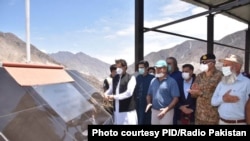Pakistan and close ally China have formally launched construction at a multibillion-dollar dam in the Pakistan-administered part of the disputed Kashmir region, ignoring rival India’s objections to the project.
Prime Minister Imran Khan of Pakistan visited the site Wednesday along with top military leaders and the Chinese ambassador in Islamabad to mark what officials hailed as a "historic milestone.”
The Diamer Bhasha multipurpose dam is expected to be completed in 2028, with a total cost of more than $8 billion. It is expected to generate 4,500 megawatts of inexpensive and clean electricity.
“This will be Pakistan’s third large dam, whereas neighboring China has built nearly 5,000 large dams out of its more than 80,000 dams in total,” Khan said.
The dam, with a usable storage capacity of about 6.5 million acre-feet of water, will stand at a height of 272 meters in northern Gilgit-Baltistan region, about 400 kilometers from Pakistan’s only overland crossing with China.
Officials said the project will also help in flood control and add 1.2 million acres of agriculture land, in addition to creating 16,000 jobs for local residents.
A consortium of state-owned China Power and the Pakistan army’s commercial wing, Frontier Works Organization (FWO), is building the project on a 70-to-30 ratio.
India, which controls most of Kashmir and claims it in its entirety, as does Pakistan, has denounced the project as a violation of its territorial sovereignty.
The Pakistani and Chinese governments have rejected Indian concerns as misplaced, insisting the economic collaboration is aimed at improving “the well-being of the local people.”
CPEC collaboration
The dam, however, is not part of the ongoing multibillion-dollar China-Pakistan Economic Corridor (CPEC) project, a centerpiece of President Xi Jinping’s global Belt and Road Initiative (BRI).
Beijing has also signed within the past month two agreements with Islamabad under the CPEC to directly invest up to $4 billion to develop two hydroelectric power projects in Kashmir, with a total capacity of about 1,800 megawatts.
Michael Kugelman, deputy director at the Asia program of the Washington, D.C.-based Wilson Center, sees the growing Chinese investments in Pakistan-administered Kashmir a blow to India.
“These moves will bring one more tension point to an India-China relationship that is already more strained now than it has been for several decades,” he said.
Kugelman was referring to last month’s border clash between the two countries in the western Himalayas in which 20 Indian soldiers were killed. Chinese and Indian officials are currently engaged in talks to ease the tensions.
“We can also read them, in part, as a defiant response by both Beijing and Islamabad to increasing Indian verbal threats in recent months to make some sort of move on Pakistan-administered Kashmir,” said Kugelman.
Indian leaders have repeatedly alleged in recent months that militants are preparing to infiltrate into India-controlled Kashmir from the Pakistani side and warned of a cross-border counter military action which would fuel mutual tensions.
China has invested about $29 billion in Pakistan, including direct investment, soft loans and grants, which has been or is building power plants, roads, rails, the new deep-sea port of Gwadar and an adjoining international airport in Baluchistan province.
Chinese and Pakistani officials say the investment has created an estimated 75,000 jobs for locals and effectively reduced, if not ended, years of crippling power blackouts in Pakistan.
“Despite the outbreak of COVID-19, work on the CPEC has been underway in full swing, and new projects under the mutual collaboration will be launched in coming days,” Asim Saleem Bajwa, an aide to the prime minister who is overseeing the massive the program, told a recent meeting of Pakistani and Chinese officials.
Bajwa was apparently responding to reports that the coronavirus pandemic has slowed work on CPEC projects.
'Debt trap'
CPEC investments, however, have worried critics at home and outside Pakistan, who have expressed concerns and skepticism in the wake of the financial crunch facing the country.
The United States also has been critical of the bilateral undertaking.
Alice Wells, who recently retired as the Trump administration’s senior diplomat for South and Central Asia, had been publicly warning that Chinese investments under the CPEC could become a debt trap for Pakistan in the long run, citing relatively high costs and alleged lack of transparency in contracts, among other concerns.
“Hopefully, not at the cost of Pakistan’s sovereignty, environment, sustainability of debt or corruption. This is a good time to renegotiate BRI terms that, in hindsight, were disadvantageous or one-sided,” Wells tweeted earlier this month.
She was responding to comments by Khan that his government would complete the estimated $40 billion to $60 billion CPEC project “at any cost” for it being “the future of Pakistan.”
Islamabad and Beijing have vehemently rejected as misplaced concerns about the CPEC being a “debt trap” or a burden on Pakistan’s economy.
“CPEC, as flagship of BRI, is already a success story, and has entered its second phase successfully," noted Mushahid Hussain, who heads the Pakistani Senate’s foreign affairs committee. “Energy and infrastructure projects have been completed on schedule, 75,000 Pakistanis have got jobs in BRI projects, and 28,000 Pakistani students are studying in China.”









